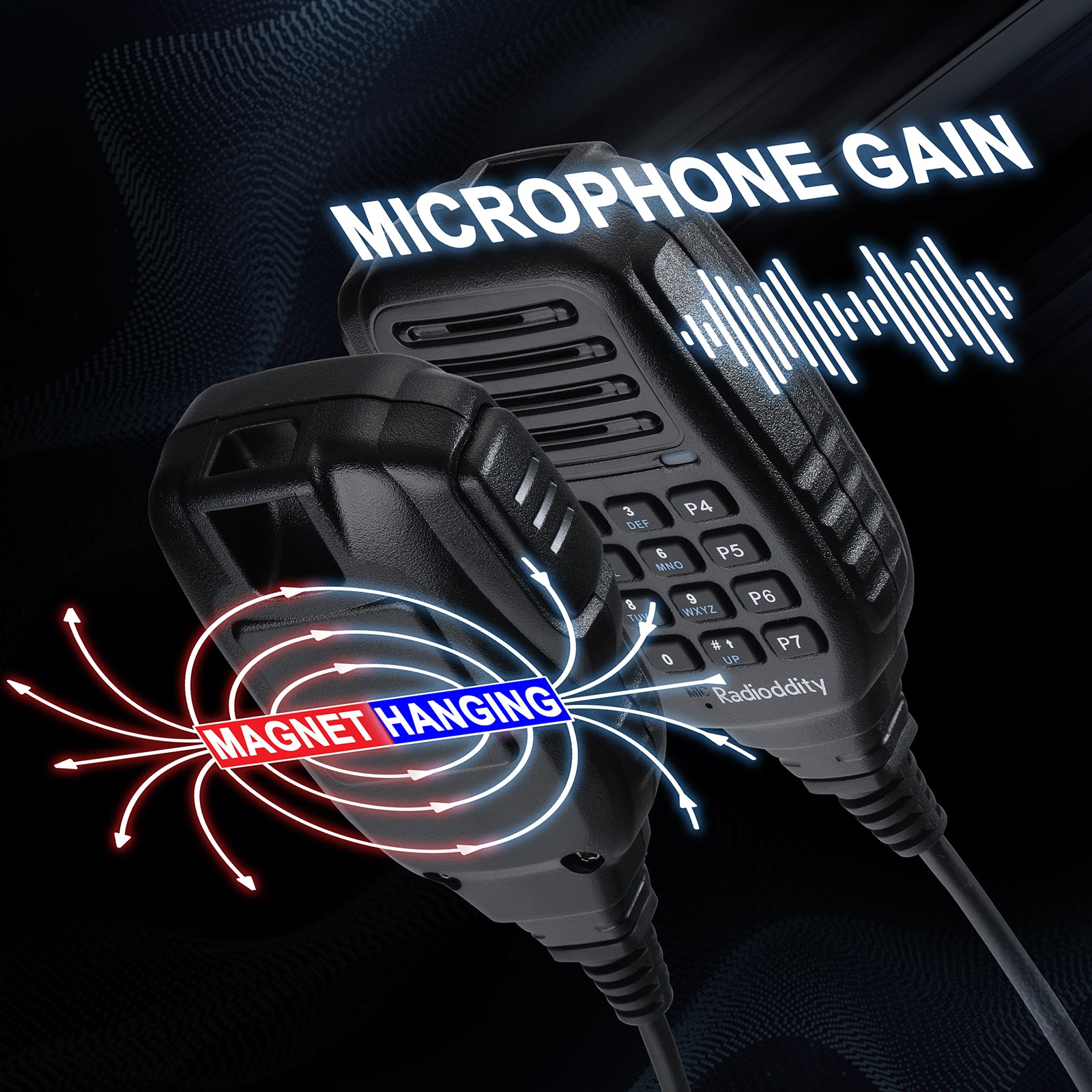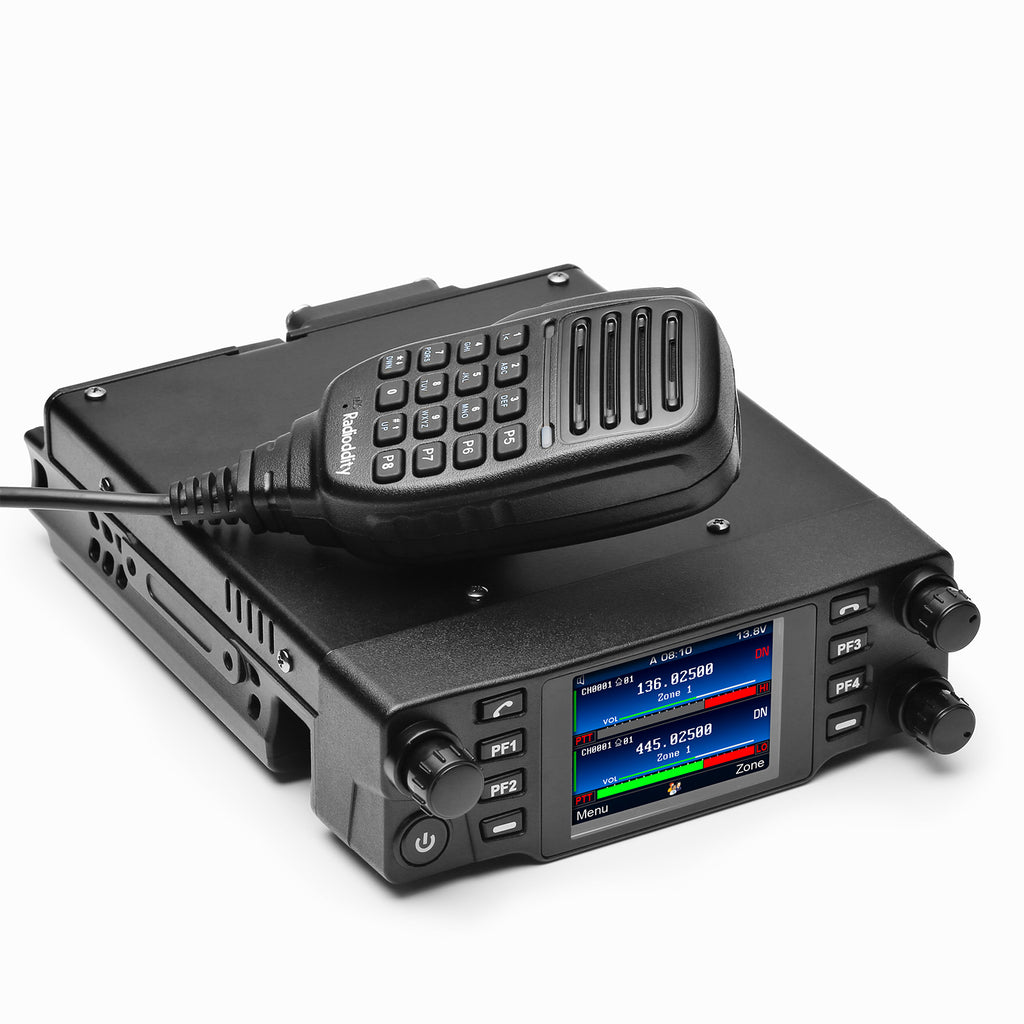As one of the most compact DMR mobiles in the market, the Radioddity DB25-D is about the size of a handheld radio. Small but powerful would be the perfect description for this palm size mobile radio.
The DB25-D supports both digital and analog mode operation on VHF/UHF frequencies. It features 20W high power output, 500k DMR contacts storage and 7 customizable function keys. What’s more, DB25-D comes with GPS function, supporting APRS, being your ideal choice for off-road and outdoor use.

|

|

|

|
APRS enables your radio to send and receive packets of GEO-information include text messages, weather information, and GPS data. Your friends can track you easily when you’re traveling in the backcountry.
CLICK HERE to learn about how to set up APRS. |
The Radioddity DB25-D comes with a microphone option, which can be set according to different situations in order to improve your TX audio quality. |
Knowing the fact that more and more people are migrating to DMR operation, the DB25-D supports larger digital contacts storage while providing 198 hours of audio recording and with its dual mode capability, making migration even easier. |
The DB25D has a total of 7 customizable function keys that can activate the preset functions. Each key has Long / Short press option, making up a total of 14 different functions being available with a single keypress. |
Feature Functions
- VFO, SMS, TOT, GPS, APRS, Alarm Mode
- 198 Hours of Recording
- 9 Level Squelch
- DMR Tier 2 (for dual timeslot as required by repeaters)
- Busy Channel Lock-out, Automatic Keypad Lock
- IP54 Waterproof
- Color Screen, Cooling Fan
- 7 Customizeable function Keys
- Programmable Microphone Gain
- Speaker Mic with magnet for hanging
Radioddity DB25-D
Radioddity DB40-D
https://www.radioddity.com/products/radioddity-db25d
https://www.radioddity.com/products/radioddity-db40-d
Frequency
Power Output
Screen
DMR ID
GPS Type
Customized Keys
Bluetooth Earpiece
Bluetooth PTT
Same frequecy repeater
SFR
Cross-band repeater
FCC ID
CE ID
Channel + Zone
Dual Watch
Beep Tone
Squelch Level
VOX
CTCSS & DCS
DTMF
STE-Squelch Tail Elimination
Power On Message
Repeater Tone
SMS
Time Slot Tier 1/2
VFO
Analog APRS
Digital APRS
Talker Alias
136-174/400-480@@10W/ 20W@@1.8" Color@@500K@@Passive@@7@@X@@X@@X@@X@@X@@2AN62-DB25D@@√@@4000@@√@@√@@√@@√@@√@@√@@√@@√@@√@@√@@√@@√@@√@@√@@√@@
136-174/400-480@@20W/ 40W@@2.4" Color@@500k@@Active@@10@@√@@√@@√@@√@@√@@VO6CDR-700UV@@√@@4000@@√@@√@@√@@√@@√@@√@@√@@ √@@√@@√@@√@@√@@√@@√@@√
Specifications
Frequency: VHF 136-174MHz | UHF 400-480MHz
Mode: Analog + DMR (Tier 2)
Power Output: 20W | 5W
Channels: 4000 (ch+zone)
Contact ID: 2000
DMR ID Data Base: 500,000
CTCSS/DCS: 51/108
Bandwidth: 12.5kHz/25kHz
Antenna Connector: SL16 / PL-Type
Compatibility: compatible with Mototrbo
Screen: 1.77〃TFT screen
Size: 4.8 x 2.6 x 1.7in | 12 x 6.5 x 4.2cm
Weight: 2lb | 0.9kg
Antenna Port: SO-239
Need Antenna with Port: PL-259
What's in the box
1 x Radioddity DB25-D Mobile Radio
1 x Mini GPS Antenna
1 x Programming Cable
1 x Power Cable (connected with a car adapter)
1 x Mounting Bracket (with 2 screws)
2 x Mounting Screws
1 x Speaker Mic
1 Year and 6 months Manufacturer's Warranty.
• This warranty from Radioddity covers all new items (except Xiegu brand)
purchased from radioddity.com. For purchases made
through other platforms like Amazon, eBay, and Walmart, we offer a 1-year
warranty period from the date of purchase. The specific warranty terms may vary
depending on the authorized dealer.
• This warranty cannot be transferred. You need to provide proof of purchase
from us or an authorized dealer to avail warranty service.
• For Xiegu brand items, we offer a 1.5-year warranty for the G90, X6100, and
X5105 models starting from September 14, 2022. All other models come with a
1-year warranty.
What Does This Limited Warranty Cover?
We warrant that the Products are free from defects in materials and workmanship
under normal use and use in accordance with the respective Product user manual,
during the Warranty Period. Please refer to the Instructions inside each package
for a description of proper use and care of the unit.
What Does This Limited Warranty Not Cover?
This limited warranty does not cover damages directly or indirectly arising or
resulting from or during:
(1) accident, misuse, abuse, vandalism or acts of God (including lightning and
other weather conditions)
(2) use with another product or other damage or loss suffered by the use or
combination of any other item
(3) improper or inadequate maintenance
(4) repairs by an unauthorized service technician
(5) normal wear and tear
Open Box
Open Box items are products that have damaged packaging or are otherwise not
suitable to be sold as new. All items are tested to be working by a member of
our team.
Open Box items come with a 6-month warranty instead of the standard 18 months
warranty and are not eligible for any warranty extension offered to new
products. We will not accept returns of Open Box items due to cosmetic damage or
other non-performance-related issues. All sales of Open Box items are final and
not eligible for a return or refund.
If for some reason the item is defective on arrival, please contact
support@radioddity.com
so we can arrange a replacement.
If you are satisfied with our products and service, please kindly leave us a
positive product review. Any problem, be free to contact us
support@radioddity.com
We strive to answer all emails as quickly as possible, but due to high email
volume, it may take time for us to reply. Thanks in advance for your patience!
Order Processing
All orders are processed within 1-2 business days after we receive
your full payment, excluding weekends and holidays.
As soon as your order is ready, we’ll update the tracking number and send it to
you if you’re a Radioddity Member. We highly recommend that you register as a
Radioddity Member
here.
If the item you ordered is temporarily out of stock, our customer service team
will reach out to you. You can choose to wait until the item is back in stock or
cancel your order.
Please be aware that we have several distribution centers globally. Therefore,
your orders may be shipped from various locations including the United States,
Canada, Europe, or China, depending on the availability of the product in our
inventory.
Flat Shipping Rates
|
Country
|
US
|
EU
|
Outside US & EU
|
|
|
Free when order amount ≥ $99.99
|
Free when order amount ≥ $99.99
|
Free when order amount ≥ $99.99
|
|
Flat fee
|
$9.99
|
$9.99
|
$9.99
|
|
Ship from
|
➤ United States
➤ China
|
➤ Germany
➤ China |
➤ China
|
|
Handling time
|
1-2 business days |
1-2 business days |
1-2 business days |
|
Delivery time
|
5-7 business days
|
5-7 business days
|
7-15 business days
|
Note:
1. Customs fee included for US & EU countries.
2. Please note that taxes will be applied to shipping rates. These taxes will
be calculated and added to your total at checkout.
3. US Shipping does not include Alaska, Hawaii and Puerto Rico area.
Please contact us for a detailed shipping fee to these areas.
4. For EU countries, please be aware that the listed product prices do not
include VAT.
5. For shipping options to other countries, please visit our
EXPANDED INTERNATIONAL SHIPPING page.
6. Please be aware that for outlet items, pre-orders, and open box items, the
shipping services and charges may vary.
How Do I Change The Shipping Address Or Cancel My Order
Contact support@radioddity.com (CLICK HERE) immediately if you need to change the shipping address or cancel your order. Please be advised that some orders are shipped very soon after placement and it will not always be possible to make changes to the shipping address and/or cancel the order.
Frequently Asked Questions
1. What forms of payment do you accept?
Radioddity.com currently accepts PayPal* or credit card for all orders.
*When purchasing with PayPal, your shipping address will automatically default to the address on file with PayPal, regardless of the shipping address you enter on your Radioddity.com order.
2. Why has my credit card payment failed?
Payment with a credit card may fail because of bank authorization and fraud prevention systems. If you are having trouble making a payment via Credit Card, you may contact your card issuing bank or PayPal directly. Here are PayPal's phone numbers:
+1-888-221-1161 (US & Canada Toll Free) +1-888-215-5506 (US & Canada Toll Free)
+1-402-935-7733 (International) +1-402-935-2050 (International)
3. How do I know if it is safe to shop with you?
Radioddity.com takes great pride in offering a safe and secure online shopping experience. We also respect your privacy and we're committed to protecting it.
4. Is there any discount for bulk/volume purchases?
Radioddity does provide discounts for some bulk/volume purchases. Please email our customer service for more details.
5. Do you ship internationally?
Yes, we do! We ship to US & EU countries. For some products, we ship to CA.
6. How can I contact Radioddity.com for additional assistance?
Email Customer service:
please email us via support@radioddity.com, and we will respond to your email as quickly as possible, usually within 24-48 hours.
7. How are warranties handled?
Repairs on defective merchandise are handled by the manufacturers and not by Radioddity unless otherwise indicated. If any item arrives damaged due to shipping, immediately contact the courier. Keep all shipping materials and contact us immediately.
8. Why didn't I receive an order confirmation email after my PayPal payment is completed?
We send a confirmation email to your primary PayPal email address or the e-mail address you have specified if you used the "PayPal Express Checkout" method. Make sure that you have a Radioddity account registered under your PayPal account's primary e-mail address.
In rare circumstances, a technical bug confirmed by PayPal can get in the way. If you do not receive any information at all, and your order does not appear in your Radioddity account, please contact us and send us your order details.
9. How do I change the shipping address or cancel my order?
Please contact customer service immediately if you need to change the shipping address or cancel your order. Please be advised that some orders are shipped very soon after payment and it will not always be possible to make changes to the shipping address and/or cancel the order.
10. What does Radioddity.com charge for shipping order and how long will it be before I receive my order?
Please CLICK HERE to
learn about our shipping policy.
11. Do you ship to PO boxes or Military APO/FPO addresses?
Only USPS can ship to both PO Boxes and Military APO/FPO addresses. The items have to be less than 2kg. Please allow additional time for orders to be shipped to these addresses. Express shipping cannot be sent to both PO Boxes and Military APO/FPO addresses.
12. Why am I unable to track my order?
It can sometimes take 24-48 hours or so for tracking information to update once an order has shipped from our warehouse.
Occasionally, a package may not receive the proper origin and transit scans while on its journey to you, so neither us nor express is able to track the exact location of the package in transit.
Please email us if you do not receive your order by the end of the quoted time frame. Please note that orders shipping via UPS can be delivered as late as 9:00 pm local time in some areas.
13. Taxes, Customs, & Duties
If the package is checked by your country's customs office when the item arrives in your country, most websites are declaring that you are responsible for import duties, tariffs, and taxes. However, Radioddity will be happy to go fifty-fifty with customers. Quality customer service is our highest value and we try our best to reduce our customer’s loss.
14. How do I return products if I am unsatisfied?
Please CLICK HERE to
learn about our return policy.
15. What do I do if received the wrong item?
Return the wrong item. If the item you received is completely different from the one you ordered, please contact our Customer Service with photos or videos of the different product. If a return is necessary, replacement plus return shipping cost will be issued to you on receiving the returned product. Or if you decide to keep it, we will offer a 10% discount for buying it.
16. How do I return defective items?
If your product turns out to be a defective one with physical damage within 30 days from the initial receiving date. You can mail the item back in the original package without any wear and tear for a free replacement. However, you will need to provide photos and videos showing the defect(s) of the product.
*NOTE: We strongly recommend obtaining and saving your return tracking number until you are notified that we have completed your refund.*
17. When will a replacement be sent?
Replacements are treated the same way as that of new orders -- they typically arrive in 10 to 13 days. If a product needs to be returned for replacement, the replacement is sent after receiving the returned item.
18. How long does it take for me to get a refund?
It may take 1 or 2 weeks for your return to reach our warehouse. Once it is received and inspected (usually within 72 hours of arrival) your refund will be processed and automatically applied to your credit card or original method of payment within 2 days. Please note that depending on your credit card company, it may take additional 2-10 business days after your credit is applied for it to post to your account.
![Radioddity GD-168 [OPEN BOX] - Radioddity](http://www.radioddity.com/cdn/shop/files/GD-168_1600x1600_3922a234-2fe4-4b80-8282-3f6d17a10d71.png?v=1762470234)










![Baofeng GT-5R 5W Dual Band Radio [Upgraded Legal Version of UV-5R] - Radioddity](http://www.radioddity.com/cdn/shop/products/GT-5RImage.png?v=1762459898)
![Baofeng UV-5R PLUS [5 Colors] | DUAL BAND | 4/1W | 128CH | FLASHLIGHT - Radioddity](http://www.radioddity.com/cdn/shop/products/3_58c037e1-560a-4c85-bd75-67c202269d29.jpg?v=1762457615)










![GA-2S UHF Long Range USB Two way Radio [2/4/6 Packs] - Radioddity](http://www.radioddity.com/cdn/shop/products/5_96d2d28c-8609-4f29-926b-d423141df2f4.jpg?v=1762457835)



![Baofeng BF-888S [2 Pack] | UHF | 5W | 16CH | CTCSS/DCS | Flashlight - Radioddity](http://www.radioddity.com/cdn/shop/products/1___1___1.jpg?v=1762457605)
![Baofeng GT-1 [2 Pack] | UHF | 5W | 16CH | Flashlight | FM Function Two-Way Radio - Radioddity](http://www.radioddity.com/cdn/shop/products/ia_100000006122.jpg?v=1762457668)











































